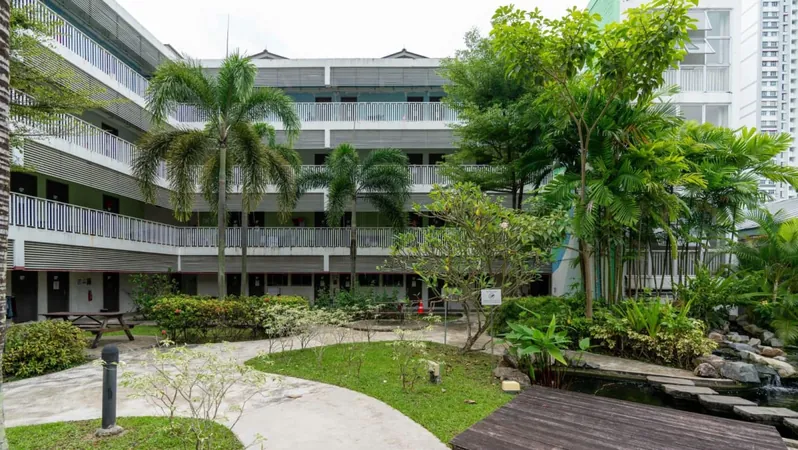
Intergenerational Co-Living: A Game-Changer for Seniors in Singapore?
2024-09-24
SINGAPORE: As Singapore gears up to achieve 'super-aged' status by 2026 — with over 21% of its population being 65 years and above — innovative housing solutions are becoming crucial. By 2030, projections indicate that one in four Singaporeans will be seniors, necessitating creative housing options to accommodate their needs.
In response, the Singapore Land Authority (SLA) recently launched its first tender aimed at fostering 'silver co-living proposals.' This initiative seeks to enhance options for independent seniors, allowing them to engage in communal living without the constraints typical of assisted living facilities.
The SLA has noticed a growing demand for co-living spaces, as evidenced by the considerable interest shown through past tenders — seven in total over the last two years, receiving over 70 bids collectively. The tender for 98 Henderson Road, previously home to Henderson Primary School, specifically seeks to explore intergenerational co-living models, which are increasingly popular globally.
How Does This Work for Seniors?
Experts have expressed optimism regarding new eldercare residential options, with successful models already implemented in various parts of the world. For instance, Kampung Admiralty, Singapore's pioneering "retirement kampung," provides integrated housing with healthcare and wellness facilities on-site. Another similar facility is expected to open in Yew Tee by 2027.
Private sector initiatives, like St Bernadette Lifestyle Village, are already operational, offering round-the-clock care in family-style living arrangements for small groups of seniors. However, researchers like Ms. Chia Hui Xiang from the Lee Kuan Yew School of Public Policy emphasize the need for diverse housing models that cater to the varying preferences and conditions of seniors.
Globally, successful senior co-living examples often shrink the gap between generations. Take Aoi Care in Japan, where independent seniors can organize their own activities and engage with the surrounding community, fostering beneficial social interactions.
Bridging the Generational Divide
The 98 Henderson Road project is strategically placed next to a former school site, currently home to a childcare center, nursing home, and urban farm. This proximity allows for rich interactivity between seniors and the younger population, providing avenues for shared activities and mutual care.
As noted by experts, building connections across generations is vital. In Taipei, senior apartments that integrate university students have thrived, with students paying reduced rent in exchange for facilitating activities that engage both groups. Similarly, the Joo Chiat Social Club in Singapore creates organic intergenerational interactions through regular volunteer-led activities involving young children and seniors.
A Call for Thoughtful Solutions
While the idea of co-living appears promising, some professionals caution against downplaying the need for care services in these housing models. Dr. Belinda Wee advocates for a well-balanced approach where seniors maintain independence while having access to necessary medical support.
As the co-living concept rolls out, experts predict it may initially attract a niche market, particularly among those already familiar with such arrangements. Nonetheless, exploring diverse models is fundamental as Singapore prepares to navigate its aging landscape.
The SLA plans to award the Henderson Road tender by late 2024. Experts recognize that converting old public properties into dynamic living spaces is an innovative approach, albeit challenges related to short lease terms may arise.
Creative solutions are imperative. With rising land costs, the success of this initiative will depend on how enticingly it can offer sustainable living arrangements for seniors while ensuring financial viability for those who invest in these concepts.
The future looks promising for intergenerational co-living in Singapore, setting a new standard for aging gracefully while reinforcing community ties. Will this become the preferred lifestyle choice for seniors? Only time will tell!




 Brasil (PT)
Brasil (PT)
 Canada (EN)
Canada (EN)
 Chile (ES)
Chile (ES)
 España (ES)
España (ES)
 France (FR)
France (FR)
 Hong Kong (EN)
Hong Kong (EN)
 Italia (IT)
Italia (IT)
 日本 (JA)
日本 (JA)
 Magyarország (HU)
Magyarország (HU)
 Norge (NO)
Norge (NO)
 Polska (PL)
Polska (PL)
 Schweiz (DE)
Schweiz (DE)
 Singapore (EN)
Singapore (EN)
 Sverige (SV)
Sverige (SV)
 Suomi (FI)
Suomi (FI)
 Türkiye (TR)
Türkiye (TR)